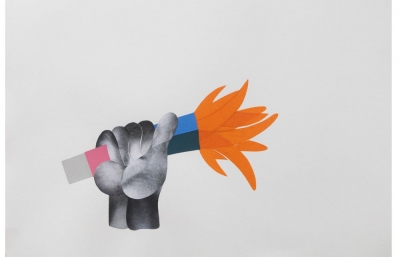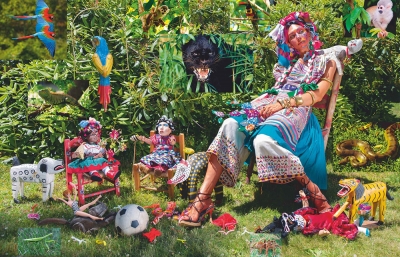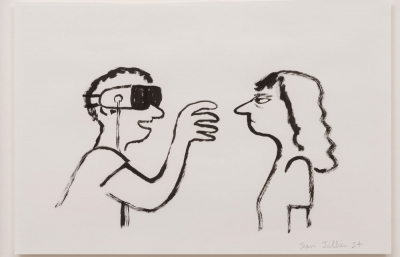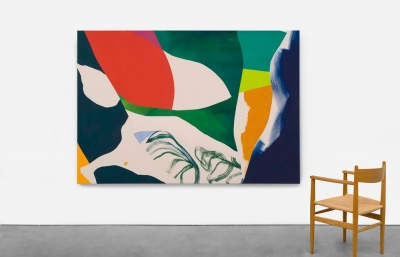In what will be one of the most-anticipated shows of the summer, Roberts Projects is pleased to present Bíikkua (The Hide Scraper), an exhibition of Wendy Red Star’s ongoing series exploring the social and material history of bishkisché. This Apsáalooke term is used to describe heirloom rawhide cases fabricated and decorated by the women of indigenous tribes throughout North America, translating to “backpack for dogs to carry meat or grain.” Historically referred to as parfleche—a French phrase introduced during the colonial fur trade—in Western European scholarship, Red Star intends to use this series to restore the creative lineage and language of her Apsáalooke ancestry. A functional object used for transporting goods and possessions on horse across the Great Plains, each bishkisché features two painted panels with a mirrored pattern—a unique visual symbology invented by their maker. Growing up on the Crow Indian Reservation in Montana, Red Star recalls her grandmother with a creative project always in hand—perpetually sewing, beading, and drawing. While her matrilineal ancestors may not have described themselves as artists, they had robust artistic practices and established the aesthetic vocabulary of their tribal community—envisioning vibrant, geometric designs comprised of intersecting triangles, zig-zagging lines, and lean sequenced rectangles rendered in rich primary- toned pigments.
The designs found on these utilitarian cases are representative of both Apsáalooke and Plateau aesthetics. While each tribe has its own distinct style, there are similarities between their handiwork as a result of their shared history of craftsmanship and trade. Red Star's project aims to acknowledge and explore how the material cultures of these tribes became intertwined over the course of time, while highlighting the unique artistic tradition of each. By researching and documenting existing bishkisché from various sources, she creates painted studies that serve as a new art historical record. In doing so, Red Star honors the rich legacy of both Apsáalooke and Plateau women who contributed to this tradition.
Of the nearly one thousand images of rawhide bishkisché that Red Star has uncovered since embarking on this series, she has made studies of 226 bishkisché, 184 of which are on display in this presentation—accompanied by twelve historic bishkisché from the artist’s personal collection. After observing each case, she draws a sketch of its shape and design on Japanese printmaking paper, striving to replicate the heirloom as precisely as possible. Then, with acrylic paint, she brushes a buff wash across the picture plane, representing the rawhide’s natural hue, and a blue outline, an authentic reflection of the bishkisché dyed borders. To replicate the pattern, she applies one color layer at a time, starting with red, then green, followed by yellow. Through this meticulous, rigorous process, Red Star develops an intimate dialogue with the maker, tracing the nuances of her exacting hand. For her ancestors, making these bishkisché entailed the exhaustive process of hunting an animal, skinning its flesh, staking the hide, priming its surface with water, painting onto the wet skin with natural dyes—collected or traded from the surrounding landscape—using stones to outline, and sticks to fill color. Once Red Star completes a study, she cuts out the drawing and mounts it on earth-toned sandpaper, transforming the bishkisché into a unique art object—commemorating and reclaiming this tribal tradition through her singular creative vision.
Hung in a dense grid, these works form an extensive archive, piecing together common threads and visual motifs from a historical record that has been suppressed in the hands of white settlers. Of the many ruptures obscuring a complete understanding of her tribe’s history, one significant fissure is the lost birth names of Apsáalooke women. Since 1885, the American government has conducted a census of all federally affiliated tribes and—disregarding Apsáalooke’s matrilineal traditions and naming rituals—each woman was reassigned with a Christian name and a patrilineal last name. These forgotten birth names contain a bold, mystical poetry—such as her great great- grandmother’s given name: Her Dreams Are True—a means of bestowing honor and good wishes for their people in the coming generation. As no bishkisché are inscribed with the name of their maker, Red Star recognized an opportunity to use these objects to heal the influences of patriarchy and colonization on her heritage. From the same census, she collected over 1000 female names recorded from her tribe, which she has used to title her painted studies—thus creating a permanent remembrance of two women’s lives and legacies with each artwork.
Through this series, Red Star restores not only Apsáalooke women’s singular designs, and individual names, but also to preserve the landscape and lifestyle that shaped their female experience and worldview. As scholar and curator Gaylord Torrence describes in his text The American Indian Parfleche, these objects are comprised “from the details of their daily lives and the richness and love of family life and tribal associations; from the invisible spirit forces that filled their world and the profound religions and traditions that sustained their inner, sacred lives; and from their intimate relationship with nature and the sweeping, monumental landscapes and incomparable light of the American West, which was their home.” These geometric abstractions—which have been appropriated time and again by Western artists—are coded with the intricate histories of the Apsáalooke, and it is Red Star’s prerogative to expand this revised, inclusive art historical canon until every bishkisché, and every woman, is given the credit she deserved.
Stay tuned for our interview with Wendy Red Star in the FALL 2024 Quarterly.












